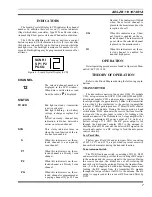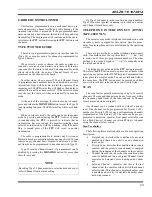
ALIGNMENT
This section describes the alignment procedure for the
radio. This procedure should be used whenever a board or
component is replaced or the operation of the radio is in
doubt.. Almost all alignment and checks can be accom-
plished through the Universal Device Connector (UDC) us-
ing the maintenance section of the PC Programming
Software. The setting of the transmitter deviation requires
the removal of the front case of the radio to adjust VR402
and/or VR403.
TEST EQUIPMENT
The following test equipment is recommended for radio
alignment:
•
Communications Monitor (HP8920B or equivalent)
•
DC Voltmeter (1 megohm input impedance)
•
DC Power Supply (7.5 volts at 5 amp)
•
IBM or compatible personal computer
•
PC Programming Software
•
Programming Adapter Box TQ-3370 with Interface
Cable
•
Radio Programming Cable
•
DC Power Adapter
•
DC Power Cable
•
RF Coaxial Cable (50 ohms)
Initial Setup
1.
Remove the channel select and volume knobs. Then
remove top cover and front case from radio.
2.
Attach DC power adapter to radio and set voltage on
power supply for 7.5 volts.
3.
Connect Programming Adapter TQ-3370, interface
cable and radio programming cable between computer
and radio UDC.
4.
Connect radio to Communications Monitor.
5.
Turn on radio and note that all LCD segments light.
6.
Program the default personality file into the radio
using the PC Programming Software.
7.
Execute radio programming software and program
three (3) test channels as follows:
Channel 1
150.825 MHz
Channel 2
162.025 MHz
Channel 3
173.975 MHz
CPU Clock Adjustment C445
1.
Set communications monitor for Antenna Input mode.
2.
Ensure that CPU clock shift is turned off for receive.
3.
Monitor on Communications Monitor the 7.3728
MHz radiation leakage using any type of antenna.
4.
Adjust trimer capacitor C445 to obtain 7.3728 MHz
50 Hz.
5.
Enable CPU clock shift and confirm that clock shifts
approxi800 Hz.
RF Output Power
1.
Select radio channel 1 and key the radio under low
power mode.
2.
If necessary, change default value to obtain the re-
quired low power output.
3.
Set the radio for high power mode.
4.
If necessary, change default value to obtain the re-
quired high power output.
5.
Repeat the above steps using channel 2 and 3.
Transmitter Modulation
1.
Apply a 1 kHz tone at standard input level (14 mV) to
the transmitter audio input.
2.
Adjust modulation control VR403 to obtain 3.0 kHz
deviation without Channel Guard.
3.
Apply a 1 kHz tone at the standard input level (+20
dB) to the transmitter audio input.
4.
Adjust LIMITER CONTROL value to obtain 3.75
kHz deviation without Channel Guard.
5.
Enable Channel Guard encode and insure that total
deviation is 4.5 kHz at 25 kHz channel spacing.
6.
Repeat Steps 1 thru 5 using channels 2 and 3.
7.
Set the radio for channel 2 at 25 kHz channel spacing.
8.
Enable middle CG tone without audio input.
9.
Adjust VR402 to obtain 0.75 kHz deviation.
10.
Check lowest and highest CG done for 0.6 to 0.9 kHz
deviation.
11.
Enable DCG code 627 and check that deviation is 0.6
to 0.9 kHz.
Squelch Level
1.
Select radio channel 2 at 25 kHz channel spacing.
2.
Increase the receiver input signal level to produce 8
dB SINAD.
3.
Decrease the default Squelch_Open_MID (Squelch
High) value until squelch opens.
4.
Decrease the input signal level by 3 dB.
If transmitter modulation does not require adjustment, begin
with Step 5.
NOTE
The front cover of the radio must be removed to gain access
to modulation controls VR402 and VR403.
NOTE
AE/LZB 119 1874 R1A
20
Summary of Contents for KPC-300
Page 1: ...ericssonz Maintenance Manual KPC 300 400 Portable Radio ...
Page 8: ...Figure 5 Block Diagram AE LZB 119 1874 R1A 8 ...
Page 29: ...EXPLODEDVIEW EXPLODED VIEWS AE LZB 119 1874 R1A 29 ...
Page 30: ...COMPONENT LAYOUT TOP BOTTOM SUB BOARD AE LZB 119 1874 R1A 30 ...
Page 31: ...COMPONENT LAYOUT MAIN BOARD TOP AE LZB 119 1874 R1A 31 ...
Page 32: ...COMPONENT LAYOUT MAIN BOARD BOTTOM AE LZB 119 1874 R1A 32 ...





























